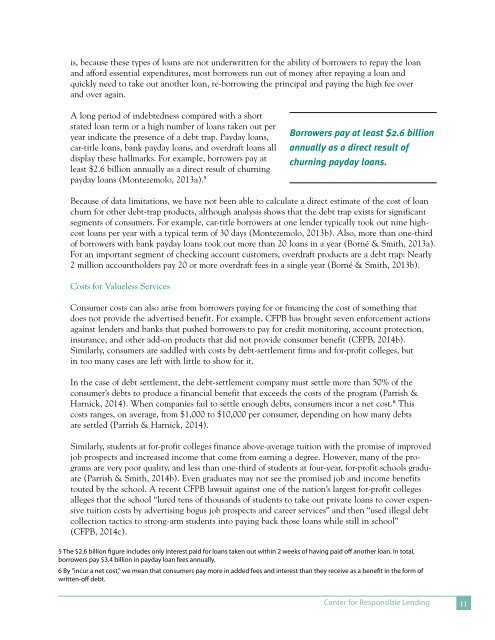You also want an ePaper? Increase the reach of your titles
YUMPU automatically turns print PDFs into web optimized ePapers that Google loves.
is, because these types <strong>of</strong> loans are not underwritten for the ability <strong>of</strong> borrowers to repay the loan<br />
and afford essential expenditures, most borrowers run out <strong>of</strong> money after repaying a loan and<br />
quickly need to take out another loan, re-borrowing the principal and paying the high fee over<br />
and over again.<br />
A long period <strong>of</strong> indebtedness compared with a short<br />
stated loan term or a high number <strong>of</strong> loans taken out per<br />
year indicate the presence <strong>of</strong> a debt trap. Payday loans,<br />
car-title loans, bank payday loans, and overdraft loans all<br />
display these hallmarks. For example, borrowers pay at<br />
least $2.6 billion annually as a direct result <strong>of</strong> churning<br />
payday loans (Montezemolo, 2013a).5<br />
Borrowers pay at least $2.6 billion<br />
annually as a direct result <strong>of</strong><br />
churning payday loans.<br />
Because <strong>of</strong> data limitations, we have not been able to calculate a direct estimate <strong>of</strong> the cost <strong>of</strong> loan<br />
churn for other debt-trap products, although analysis shows that the debt trap exists for significant<br />
segments <strong>of</strong> consumers. For example, car-title borrowers at one lender typically took out nine highcost<br />
loans per year with a typical term <strong>of</strong> 30 days (Montezemolo, 2013b). Also, more than one-third<br />
<strong>of</strong> borrowers with bank payday loans took out more than 20 loans in a year (Borné & Smith, 2013a).<br />
For an important segment <strong>of</strong> checking account customers, overdraft products are a debt trap: Nearly<br />
2 million accountholders pay 20 or more overdraft fees in a single year (Borné & Smith, 2013b).<br />
<strong>Costs</strong> for Valueless Services<br />
Consumer costs can also arise from borrowers paying for or financing the cost <strong>of</strong> something that<br />
does not provide the advertised benefit. For example, CFPB has brought seven enforcement actions<br />
against lenders and banks that pushed borrowers to pay for credit monitoring, account protection,<br />
insurance, and other add-on products that did not provide consumer benefit (CFPB, 2014b).<br />
Similarly, consumers are saddled with costs by debt-settlement firms and for-pr<strong>of</strong>it colleges, but<br />
in too many cases are left with little to show for it.<br />
In the case <strong>of</strong> debt settlement, the debt-settlement company must settle more than 50% <strong>of</strong> the<br />
consumer’s debts to produce a financial benefit that exceeds the costs <strong>of</strong> the program (Parrish &<br />
Harnick, 2014). When companies fail to settle enough debts, consumers incur a net cost.6 This<br />
costs ranges, on average, from $1,000 to $10,000 per consumer, depending on how many debts<br />
are settled (Parrish & Harnick, 2014).<br />
Similarly, students at for-pr<strong>of</strong>it colleges finance above-average tuition with the promise <strong>of</strong> improved<br />
job prospects and increased income that come from earning a degree. However, many <strong>of</strong> the programs<br />
are very poor quality, and less than one-third <strong>of</strong> students at four-year, for-pr<strong>of</strong>it schools graduate<br />
(Parrish & Smith, 2014b). Even graduates may not see the promised job and income benefits<br />
touted by the school. A recent CFPB lawsuit against one <strong>of</strong> the nation’s largest for-pr<strong>of</strong>it colleges<br />
alleges that the school “lured tens <strong>of</strong> thousands <strong>of</strong> students to take out private loans to cover expensive<br />
tuition costs by advertising bogus job prospects and career services” and then “used illegal debt<br />
collection tactics to strong-arm students into paying back those loans while still in school”<br />
(CFPB, 2014c).<br />
5 <strong>The</strong> $2.6 billion figure includes only interest paid for loans taken out within 2 weeks <strong>of</strong> having paid <strong>of</strong>f another loan. In total,<br />
borrowers pay $3.4 billion in payday loan fees annually.<br />
6 By "incur a net cost," we mean that consumers pay more in added fees and interest than they receive as a benefit in the form <strong>of</strong><br />
written-<strong>of</strong>f debt.<br />
Center for Responsible Lending 11


